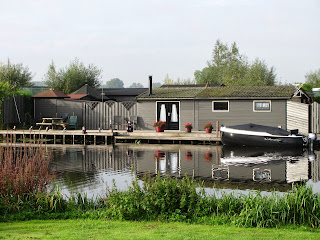The next morning when I went up to the sundeck to practice Taijiquan I realized that we were already moored at Kinderdijk. It was still dark at 6:30AM and it was foggy so I could see very little beyond the shoreline.
 |
| This was the only building that I could see from the boat early in the morning. |
By the time I finished practicing there was more light but it was still foggy. As I went back down stairs I was wondering, "where are the windmills?".
Kinderdijk is a tiny village located on a narrow strip of land between the the Lek and Noord Rivers. Kinderdijk's claim to fame is that is has the largest collection of windmills in Holland; 19. The windmills date all the way back to the 14th century. Kinderdijk has been named a UNESCO World Heritage Site.
 | ||
| In the early morning the windmills was still shrouded in mist. |
 | ||||
| This map shows the layout of the windmills at Kinderdijk. |
 |
| This is a typical home along the canal at Kinderdijk |
 |
| Here is our group trudging along the road to the windmills. Notice how flat and low the level of the ground. |
There is something magical about these windmills!
I couldn't stop taking pictures of them!
We had the opportunity to visit one of the windmills that was kept as a museum for tourists. People actually live in the other windmills.
Inside the windmill looks much like any other home of the 14th century. It had a small cozy feel.
I don't know how the miller squeezed his 11 person family into the windmill. They must have slept two and three to a bed at night!
This a picture of the gear that turns the mechanism that turns the vanes of the windmill.
We were given a demonstration of how the miller changes the direction of the windmill to catch the wind. It is a very labour intensive procedure.
The miller turns the wheel manually using his hands and feet that turns a gear at the top of the windmill which pushes rollers that turn the top of the windmill to whatever position that the miller feels will pick up the most wind.
We were given a tour of the workshop where parts of the windmill are repaired and replaced. Most of the components of the a traditional windmill are made of wood. Depending on the type of wood required and its function it would be made out of a specific type of wood depending on its hardness, softness or toughness.
 | ||
| A diagram of the inner workings of a windmill |
This one of the rollers that turns the windmill. You can see that the roller is made out of steel. These rollers have to be tough and durable in order to take the stress of moving all the weight of the windmill.
Our trip to Kinderdijk was truly fascinating. I had never seen anything like this in my life. My wife and I feel that we wee privileged to have had the opportunity to visit the windmills at Kinderdijk.












































